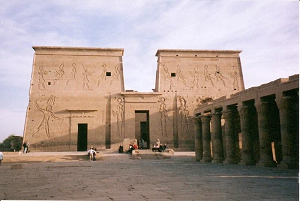Three Temples Along the Nile
Aswan
We left our hotel at 4 a.m. to make our way by bus and boat to the Temple of Philae. The full moon was haloed by a thin cloud cover and a hush came over our group as the boat approached the island. This magnificent temple, dedicated to the goddess Isis has held an iconic stature since it was built in the Ptolemaic times. The courtyard leading to the temple complex is flanked by a colonnade of columns and a separate small temple sits away from the main building on the edge of the site. The revival of the interest in the old goddess religions in the twentieth century and emergence of a new female spirituality movement has caused this and other goddess temples to be undergoing a renaissance of sorts. Isis, in the old Egyptian religion, was the Queen of Heaven, mother to all, worshipped along with her brother Osiris and her son Horus as a sort of divine trinity. Philae was the epicenter of the cult of Isis.
The Temple of Philae was originally located on an island that became flooded after the building of the Aswan High Dam. We were told by our Egyptologist guide that this temple and ten others including the famous Abu Simbel in the south, were dismantled, relocated and reassembled after the building of the Aswan High Dam. Between 1972 to 1980, the Philae temple was dismantled into 11,000 pieces and reassembled on another island where it sits today. It was a remarkable feat of engineering and without knowing the history, one would never know from observation that it had been entirely reconstructed.
Edfu
Our Nile cruise ship docked at the town of Edfu in the evening. At 9 p.m. we gathered at the dock to meet our transportation to the next temple site on our journey. Imagine our surprise to be greeted by several horse drawn carriages that looked like they had galloped out from 18th century London to gather us. Two to a carriage, we climbed in and were whisked away through dusty streets up to the gates of the Temple of Edfu. Dedicated to the falcon god Horus, this incredible temple site is in pristine condition except for some smoke damage in the interior.
The lights around the temple illuminated the exceptional relief carvings of the king and the gods etched along the outside wall. To see the temples lit at night was a definite highlight of our visit. The overwhelming majesty of these monuments and temples evokes an enchanting high drama that seems to come alive at night.
Entering the Edfu temple gates we were treated to an overview of the significance of this temple by the general manager of the site. A statue of Horus the falcon, stands as a guardian to the entrance to the great courtyard.
We wondered through the many rooms until we came to the inner sanctuary. Sitting on the floor, we were absorbed by the presence of it until finally we had to leave around midnight.
Abydos
Abydos is about ninety miles north of Luxor and at the time of our trip, there were few tourists traveling there. We were escorted there by a convoy of military escorts because Abydos is close to the area where Egypt has suffered from Islamic insurgencies at work. After the terrible tragedy that took place at Queen Hatshepsut’s temple on the West Bank in 1997, where tourists were killed by terrorists, the Egyptian government has spared no expense in protecting its valuable monuments and sites that provide the country with its needed income from tourism.
At each site that we traveled to, there were armed guards on foot, on camel, and in jeeps. I had never seen as many automatic machine guns as I did in Egypt but at least you know they are protecting you as much as possible. For this reason, Abydos had become an out of the way destination for tourists and most of the tour companies had abandoned traveling there.
The drive from Luxor took us through fields of sugar cane and date palms and past low granite hills. The Temple of Abydos was the seat of worship of the god Osiris and this was one of the most interesting and mysterious sites that we visited. The reliefs in the interior of the temple are exceptional. There is a strange building that is called the Oseirion that is located behind the main temple site. The Oseirion was built in Old Kingdom times whilst the main Abydos Temple was built by Seti I in the New Kingdom. The Oseirion is said to be the burial place of Osiris.
A fascinating mystery in the Abydos temple were some unusual reliefs on one of the interior walls. The unmistakable images of a helicopter and what looks to be like a blimp aircraft or a submarine are there carved amidst the images of Osiris and the gods. There is no explanation about what these images meant to the people of the New Kingdom times who built this temple. The Egyptologist who was with us could only point them out to us but he said there was no deciphering this. But for us, in the 20th and 21st century, these images have clear meaning. It is quite the mystery.
Egypt holds a special place in my heart and I long to return to re-visit the majestic temples and monuments. It is a destination that is so rich in art, history, architecture, culture and religion. The preservation of the ancient monuments makes the whole country a world heritage site, worthy to all humanity to come, see and experience. There is no other place that has evoked in me such wonder and a sense of the grandness of life and appreciation for history. Copyright© Kathy Stanley






